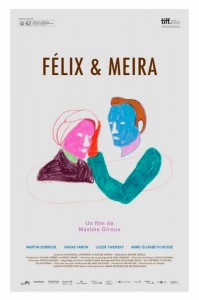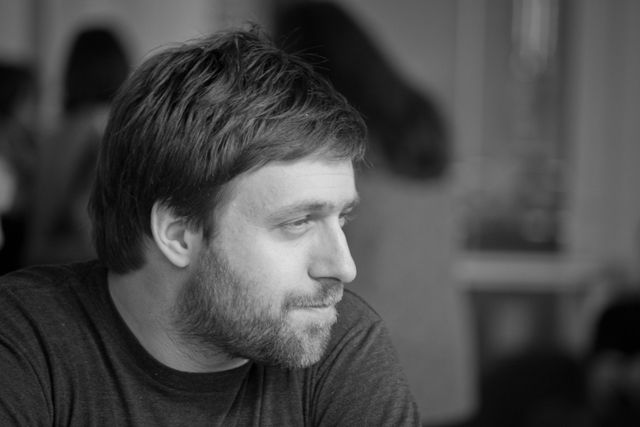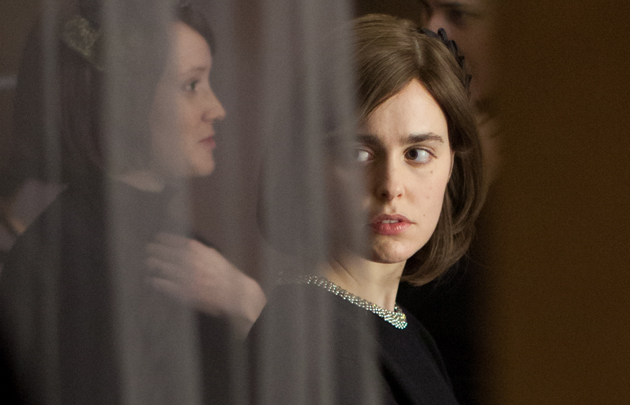Interview: Director Maxime Giroux on the Adult Romance of Canadian Oscar Submission 'Félix and Meira'
 Monday, December 14, 2015 at 8:00AM
Monday, December 14, 2015 at 8:00AM
 Jose here. In the sensitive romance, Félix and Meira, Hadas Yaron and Martin Dubreuil, play the title characters, two lovers who bond through their loneliness, but must struggle with their very different backgrounds, and the fact that she’s married to someone else. An insightful look at Montreal’s Hasidic community, the film is peculiar for its restraint and might be one of the most memorable romantic films in recent years. Director Maxime Giroux paints a unique portrait of people seeking connections that go beyond typical “movie love”. I spoke to him about the film’s origins, casting his leading lady, and being in the race for Oscar.
Jose here. In the sensitive romance, Félix and Meira, Hadas Yaron and Martin Dubreuil, play the title characters, two lovers who bond through their loneliness, but must struggle with their very different backgrounds, and the fact that she’s married to someone else. An insightful look at Montreal’s Hasidic community, the film is peculiar for its restraint and might be one of the most memorable romantic films in recent years. Director Maxime Giroux paints a unique portrait of people seeking connections that go beyond typical “movie love”. I spoke to him about the film’s origins, casting his leading lady, and being in the race for Oscar.
JOSE: At the beginning of the year I spoke to Luzer Twersky who told me the film originally was supposed to be a comedy. How did you end up with such a subdued romantic drama instead?
MAXIME GIROUX:It’s funny, when we started to imagine the movie, I’d just made a dark movie and I wanted to make a comedy. The more we talked about this community and understood it, the more obvious it became it would be difficult to make a comedy, because people like Luzer for instance, who leave the community, have a hard time making that decision. A comedy about that would not have been easy to make.
JOSE: He said instead what you ended up with was making the movie that best captured the Hasidic experience.
MAXIME GIROUX: He would know that better than me, I never lived in that community (laughs).
More after the jump... Director Maxime GirouxMaking the film you came closer to these people who had been your neighbors but whom you had never been in touch with before. What surprised you the most about them?
Director Maxime GirouxMaking the film you came closer to these people who had been your neighbors but whom you had never been in touch with before. What surprised you the most about them?
Everything surprised me! They were my neighbors and I’d tried to talk to them, but they didn’t seem to want to talk to me, which created a negative mental view of them. I did the movie because I was sure there was good in them, I realized they were like me, they wanted to have families, and wanted the best for their children. There was so much I wanted to show about what I learned, but I wasn’t making a documentary, so I couldn’t show everything.
You don’t exploit how different they are, which I found quite moving, your camera doesn’t linger longer than it should, you make everything seem so natural, which might not even be the right word to use…
You’re right though, when I realized they were just like me, I shot the scenes like I would’ve any other. Besides the surface differences, everything was the same on an emotional level.
Given the current world situation, your film is a great reminder of how people should have empathy for those with different spiritual traditions.
Yes, besides people from the Hasidic community, the film has touched immigrants, women...it’s a story of tolerance and emancipation. It’s about living side by side, not about being best friends, but about living together.
Hadas Yaron was so great, I read somewhere that you didn’t originally want her to play Meira because she’d played a similar part in Fill the Void, how did you end up going against your original instinct?
I really didn’t want her (laughs), I was searching in New York City and found some good actresses, but they weren’t exactly what I wanted. I saw a video of Hadas and she was perfect, she has something very childlike, she didn’t speak Yiddish either which was another con, but she’s such a good actress. Everything she did was so perfect. I also feel that part of the success of the film is how good the actors are.
The film’s palette and the use of shadows reminded me of The Godfather, sometimes it was as if the light was afraid to touch these characters who were going through so much emotional pain.
It’s funny that you mention The Godfather, because I don’t really need to use too many words with my DP, Sara Mishara - I’ve worked with her since university - the only thing I told her was “I want this to look like an American immigrant movie from the 1970s”, like you said the light wants to be there, but something always blocks it. The palette came from the Hasidic houses I visited, it’s a very subdued palette. I wanted to have a classic look, I want the people who watch the movie to be with the characters, not with the direction.
The 70s also gave us all these great adult romances, in which people want to connect with each other, rather than have love at first sight and all this clichés.
Yeah, they need to connect to each other because both Felix and Meira have lost faith in their own communities. It’s like in real life, the reason why we fall in love is because we’re in the same spot in our lives and decide to follow a path together. Love in real life isn’t like in the movies, it’s about timing, about what we need in our lives when we meet someone. Meira needs to feel like a teenager, and Felix in a way is a teenager.
Congratulations for the film’s success, including the award at the Toronto Film Festival. Are you excited about the film being Canada’s Oscar submission?

I’m not very nervous about it, I was not thinking about Oscars when I did the movie. I’m really happy for what this means for the actors and the other people who made the movie. They are all great people and are very proud of the film, they struggled to make it, and now their friends can see their work onscreen. I’m not nervous, whatever happens, happens. I’m enjoying everything so far. It’s been really great!
Félix and Meira is now available on DVD, iTunes and Amazon Prime.



Reader Comments (3)
Fill the Void was great. Glad that Hadas Yaron is still working.
Jose - thanks for a very informative post. It's a worthy submission, (for Oscar) but the field is very competitive this year.
I hope it at least makes the shortlist, but would much prefer a nomination.